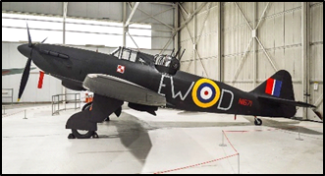Kościuszko Squadron 303
By John Cebrowski, PHC Board Member
Royal Air Force Squadron No. 303, also known as the "Tadeusz Kościuszko" Fighter Squadron, was one of two Polish squadrons that fought during the Battle of Britain (July-October 1940) and one of 16 Polish squadrons in the RAF during the Second World War. Manned by experienced veterans and initially flying Hurricane Mark I fighters, pictured below, 303 claimed the largest number of Luftwaffe aircraft shot down, 126 in six weeks, even though it joined the fray two months after that battle had begun.
The Poles were delighted to be posted to the primary fighter defense of London and the southeastern areas of the British Isles, the area where combat operations were busiest.
The Hurricane’s top speed of about 324 miles per hour, contrasted to the German Me-109 which could attain 359 miles per hour or the Me-1l0 with an average of 342 miles per hour. In their skilled hands, informed by the tactics they developed in the skies over Warsaw, it became a formidable weapon whether used against German bombers or fighters.
As the squadron's success mounted rapidly, the Brits became suspicious that the Poles were inflating their claims of success. To see for themselves a British pilot followed the squadron the next time it scrambled, on September 11. 303 Squadron rose in full twelve plane strength, along with another Polish squadron, to meet more than 150 Germans over Horsham. The Brit followed at a respectable distance, gaining altitude to watch the Poles from above. What he saw, he said he would remember for the rest of his life. Altogether, the squadron downed 14 of the 89 German aircraft shot down that day, equaling its own record for the number of victories in a single day. The British pilot came back shouting, “My God they are doing it! It was so rapid it was staggering."
How did they do it? The Poles were experienced combat pilots having flown against the Germans in Poland in 1939 and again in France in early 1940, they placed more emphasis on loose formations, eyesight, vigilance, and initiative rather than instruments and radar, and their surprise attacks came from above, breaking up German formations, and closing to 100 yards or less before firing, allowing them more accuracy. The Brits were taught to fire at a range of not less than 150 yards and preferably 150 to 300 yards.
A New York Times correspondent reported, “Poles are pure courage!"
They also had a secret weapon, Polish ground crews, both men and women, who worked tirelessly, often all night, to repair damaged aircraft. Remarkably, while other squadrons routinely took off with less than full complements of aircraft, only four times during the entire Battle of Britain did 303 have less than the normal allotment of twelve aircraft at the ready.
September 15 would prove to be the turning point of the battle. During the course of action, twelve planes from 303 Squadron and a like number from a British unit rose to intercept some 400 German aircraft making for London. In a vicious dogfight over Hastings, and another later that same day, the Poles counted 15 confirmed kills and one probable, for a loss of one pilot killed, setting a new single-day record that would not be eclipsed during the entire Battle of Britain.
Fame brought visits of notables including King George VI. During the royal visit, 303 scrambled to meet a raid of more than 80 Germans over Portsmouth. Before leaving, the king asked to be apprised of the results of the action, and 303 was proud to report later that day: “Eleven enemy aircraft shot down, one probable, our losses nil."
In a marksmanship contest in April of ‘42, 22 Royal Air Force squadrons competed for a trophy and bragging rights as the best shots in the RAF. Three Polish squadrons participated. The order of finish had 303 “Kościuszko" Squadron on top, followed by the other two Polish squadrons.
Later in the war, much of 303's work was escort missions for the increasing numbers of US Army Air Force B-17 Flying Fortress and B-24 Liberator heavy bomber missions over Europe. During those escort missions they tore into Luftwaffe opposition and many German fighters were downed.
The best fighter squadron of World War II, with 206 air victories to its credit, the Kościuszko Squadron was officially disbanded on December 11, 1946.
James Pula, Prof. Emeritus, Purdue University, contributed to this article.
Image of plane in hangar, courtesy of RAF Museum
